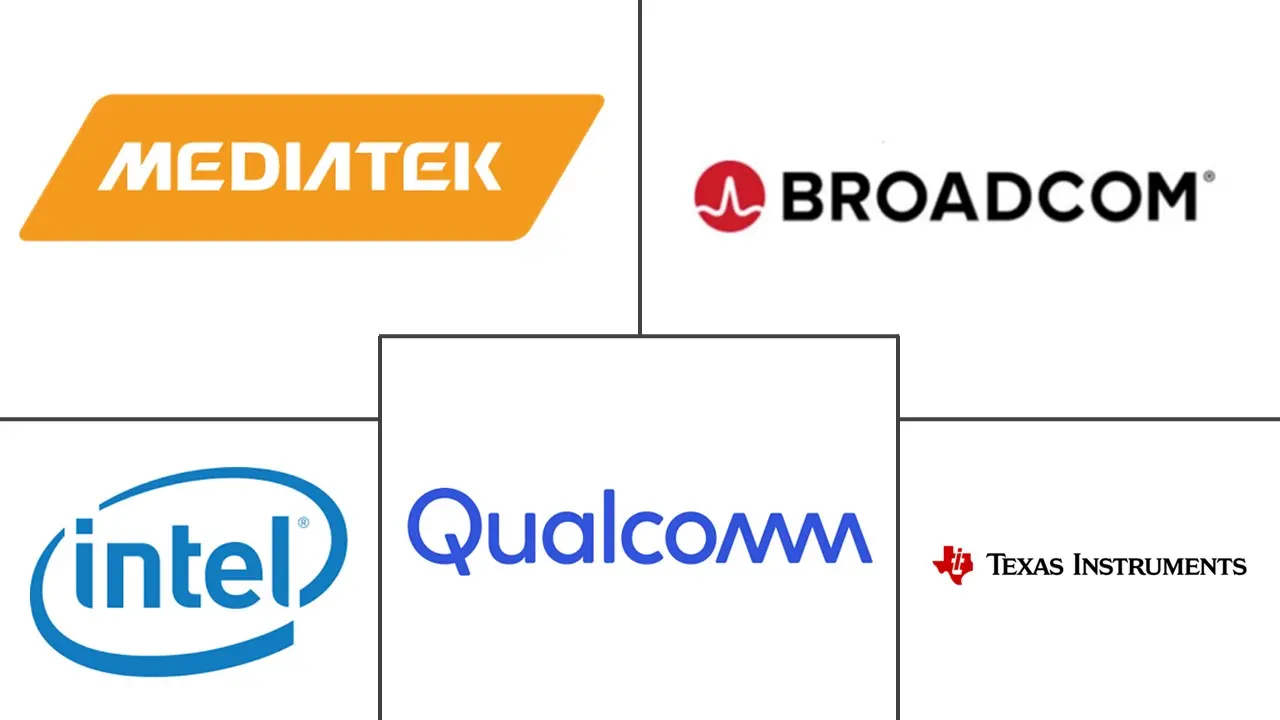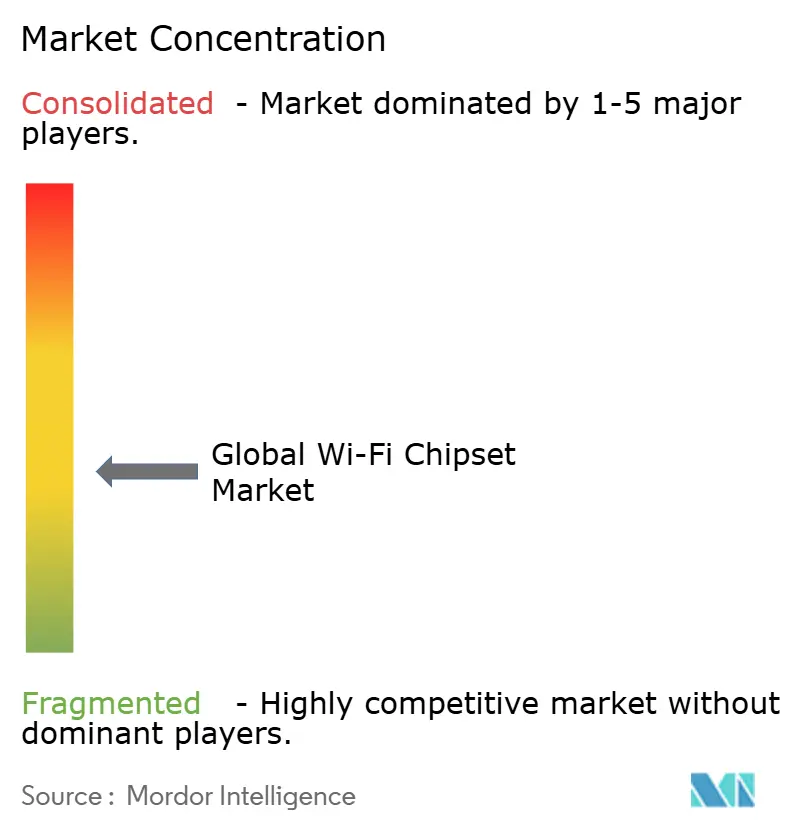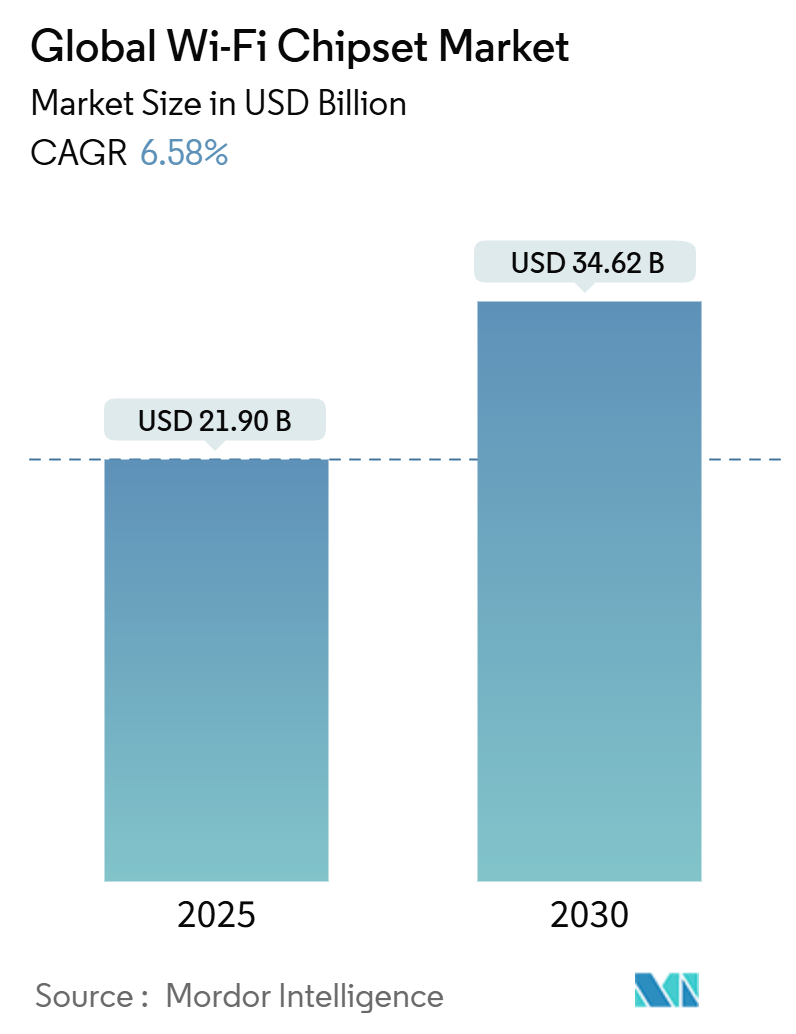
Wi-Fi Chipset Market Analysis
The Global Wi-Fi Chipset Market size is estimated at USD 21.90 billion in 2025, and is expected to reach USD 34.62 billion by 2032, at a CAGR of 6.58% during the forecast period (2025-2032). In terms of shipment volume, the market is expected to grow from 3.60 billion units in 2025 to 5.47 billion units by 2032, at a CAGR of 5.97% during the forecast period (2025-2032).
The evolution of Wi-Fi chipsets has led to their integration into a wide range of devices, making wireless networking more accessible and economical. As the price of these chipsets continues to decrease, they are increasingly embedded in everyday gadgets, enhancing connectivity and user experience.
- The growth of the market is primarily influenced by several significant factors, including increasing demand for high-speed internet, the proliferation of IoT devices, the emergence of new technologies like 5G, the rise in mobile computing, the increasing adoption of smart homes, and the rising demand for consumer electronics.
- As internet usage expands globally, consumers and businesses alike are demanding faster connectivity. The proliferation of data-intensive applications such as video streaming, online gaming, and cloud computing has intensified this need. High-speed internet is not just a luxury; it has become a necessity in both personal and professional settings.
- Consequently, Wi-Fi chipset manufacturers are under pressure to develop new technologies that can support higher data rates and broader bandwidths, leading to the adoption of advanced Wi-Fi standards such as Wi-Fi 6 (802.11ax) and the upcoming Wi-Fi 7 (802.11be). These standards promise enhanced performance, lower latency, and improved efficiency, driving demand for compatible chipsets.
- Navigating the complex landscape of regulatory compliance and certification requirements is a significant challenge for the Wi-Fi chipset market. Different regions have varying standards for wireless communication, which can complicate the development and marketing of Wi-Fi chipsets.
- Geopolitical challenges, including the Russian invasion of Ukraine, China-US competition, elections, and the war in Israel, significantly impact the global supply chain, especially critical raw materials vital for Wi-Fi chipset production. Increased inflation and interest rates reduced consumer spending, hampered the industry’s demand, and led to slow market growth. Further, the United States and China trade war further disturbed the studied market's global raw material supply chain.
Wi-Fi Chipset Market Trends
Smartphones Device Application Segment is Expected to Hold Significant Market Share
- The increasing demand for faster data transfer rates is a significant driver for adopting advanced Wi-Fi technologies, such as Wi-Fi 6 and beyond. These technologies offer improved speed and efficiency, essential for modern smartphone applications requiring high bandwidth, including streaming services and online gaming.
- Advanced Wi-Fi technologies, such as Wi-Fi 6 and Wi-Fi 6E, have significantly contributed to the adoption of wireless smartphone chipsets. This rapid adoption will provide substantial growth opportunities for wireless chip vendors in the coming years. Additionally, market vendors are enhancing their product offerings with advanced Wi-Fi technologies to capitalize on this growing opportunity.
- Wi-Fi 7 is expected to gain significant traction in the second half of 2024, driven by strong demand from mobile applications. Taiwan-based IC design houses, such as MediaTek, Realtek, and RichWave Technology, are well-positioned to benefit from this trend. Although prices remain a major hurdle for Wi-Fi 7 adoption, they are expected to decrease as production volumes increase. These companies are strategically stockpiling Wi-Fi 7 main chips and RF modules in anticipation of a surge in demand starting in Q2 2024, positioning themselves to capitalize on the upcoming shipment boom.
- The increasing number of smartphones and smartphone users worldwide creates significant opportunities for market vendors to incorporate advanced Wi-Fi technologies into upcoming smartphones, offering consumers the latest solutions for their daily needs. According to the Ericsson Mobility Report Q2 2024, the number of mobile subscriptions totaled close to 8.7 billion, with a net addition of 60 million subscriptions during the Q2 quarter. China accounted for the most net additions during the Q2 quarter (+22 million), followed by India (+8 million) and Bangladesh (+2 million). Global mobile subscription penetration was 107%.
- Furthermore, the rapid expansion of IoT devices creates a greater demand for Wi-Fi connectivity. Smartphones often serve as central hubs for controlling these devices, necessitating robust and efficient Wi-Fi chipsets to manage multiple connections simultaneously. Furthermore, the growing need for fast, reliable, and secure Wi-Fi is rapidly increasing among smartphone devices, as users increasingly rely on smartphones for downloading, sharing, and uploading large files, data transfer, online and cloud gaming, video streams, and live streams. Additionally, the growing number of smartphone subscriptions worldwide is augmenting the growth of the wireless chipset market.
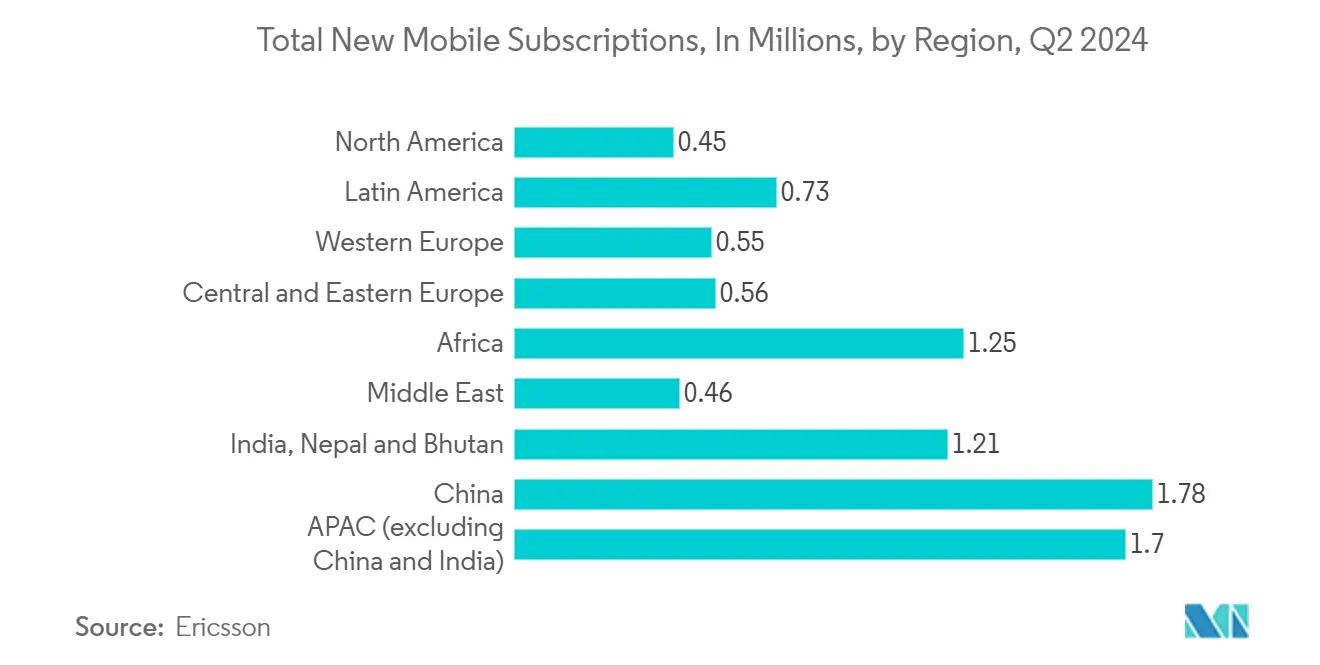
Asia Pacific is Expected to Hold Significant Market Share
- China's Wi-Fi chipset market is witnessing significant expansion, propelled by various important trends and advancements. The nation's shift towards smart manufacturing within the Industry 4.0 paradigm significantly contributes to this growth. Sectors like automotive and consumer electronics are increasingly allocating resources towards automation technologies.
- In this context, Wi-Fi chipsets provide unique functionalities and capabilities designed to meet the rigorous requirements of contemporary manufacturing settings. The Wi-Fi chipset offers sophisticated network management capabilities, facilitating enhanced control and optimization of network resources, essential for ensuring seamless operations and reducing downtime.
- South Korea is directing significant investments into research and development to steer its numerous small and medium-sized enterprises (SMEs) towards automation, to achieve market leadership, which increases demand for Wi-Fi chipsets to maintain the connectivity of industrial devices as they traverse industrial networks.
- For instance, in May 2024, the South Korean Ministry of SMEs and Startups, led by Minister Oh Young-joo, introduced an innovative initiative called "Leap Forward for Small and Medium Enterprises" to foster SME growth. This strategic framework outlines mid to long-term policy directions intended to strengthen SMEs' capabilities and international presence, which are vital to enhancing the Korean economy.
- The potential of the automation and robotics market in Japan seems bright. The government is actively backing projects such as Society 5.0, aiming to create a society that effectively merges digital technology with human capabilities. This initiative includes significant investments in artificial intelligence, big data, and the Internet of Things. In addition to government support, Japanese companies like Toyota Motor Corporation, Panasonic Corporation, and SoftBank Group Corp. are committing resources to progress in automation and robotics. These corporations are leading the way in developing innovative robots and automation tools that could revolutionize the sector, further supporting market growth.
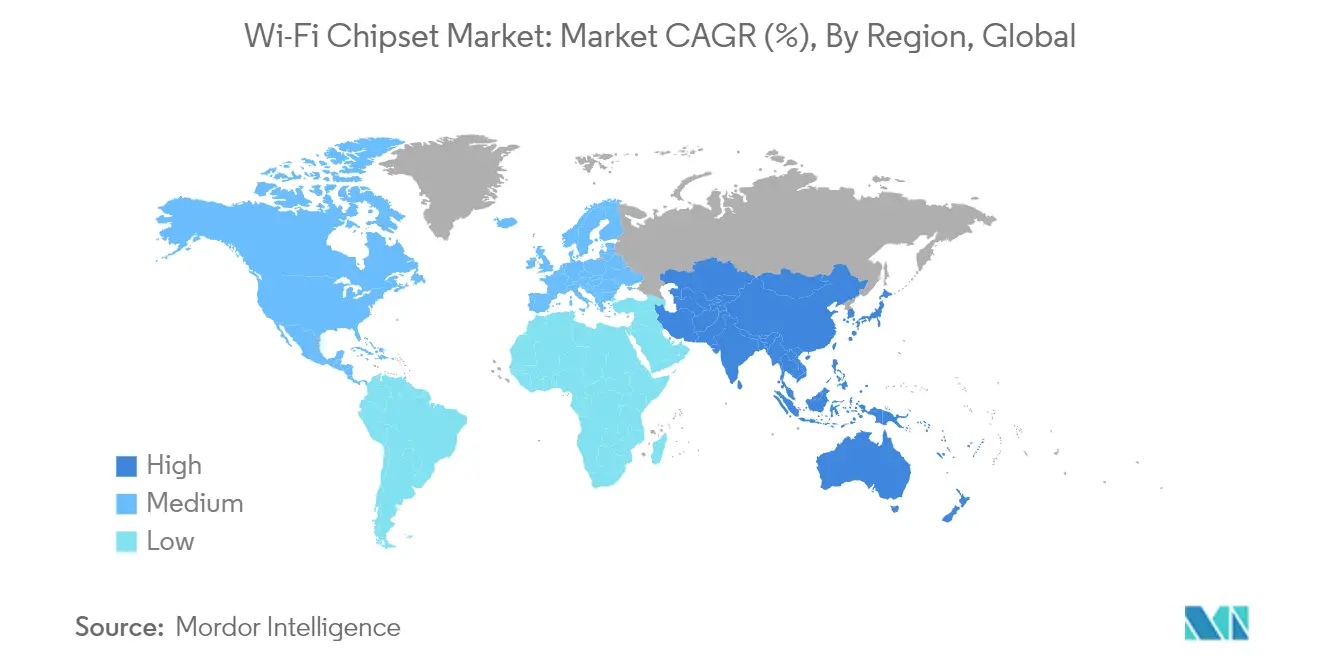
Wi-Fi Chipset Industry Overview
The presence of several manufacturers in the market studied is expected to intensify competitive rivalry during the forecast period. Market incumbents, such as Media Tek, Qualcomm, Broadcom, and Intel, influence the overall market.
These companies invest heavily in research and development to enhance the performance of their chipsets, which is crucial for maintaining competitiveness. The presence of established companies with significant resources and technological expertise intensifies rivalry as they vie for market leadership and seek to outdo each other with superior products.
Rapid technological advancements are a hallmark of the WiFi chipsets market. Innovations such as the introduction of WiFi 6 and the upcoming WiFi 7 standards have created a race among manufacturers to produce chipsets that can support these new protocols. This technological arms race leads to frequent product launches and upgrades, continually pushing companies to enhance their offerings.
With multiple players offering similar products, price competition becomes a critical factor. Companies often engage in aggressive pricing strategies to gain market share, which can lead to shrinking profit margins across the industry. Resultantly, the competitive rivalry is not only about price but also about the capability and performance of the chipsets.
The market studied is witnessing fluctuation due to increasing consolidation, technological advancement, and geopolitical scenarios. In addition, the intensity of competition in the market studied is expected to continue to rise with the increasing vertical integration of foundries and IDMs, considering their ability to invest, which results from their revenues.
In a market where the sustainable competitive advantage through innovation is considerably high, the competition is only expected to increase, considering the anticipated surge in demand from customers from the end-users. Overall, the intensity of competitive rivalry remains moderately high, mainly driven by the strong presence of the prominent players involved in the market studied.
Wi-Fi Chipset Market Leaders
-
Qualcomm Technologies Inc.
-
Broadcom Inc.
-
Mediatek Inc.
-
Intel Corporation
-
Texas Instruments Incorporated
- *Disclaimer: Major Players sorted in no particular order
Wi-Fi Chipset Market News
- November 2024: Synaptics introduced Veros Connectivity SoCs, Embracing Wi-Fi 6E. Synaptics Incorporated has rolled out its Veros Intelligent Connectivity brand, featuring advanced System-on-Chips (SoCs) equipped with Wi-Fi 6E support. These chips cater not only to developers in the Internet of Things (IoT) realm, enhancing home technologies like speakers and security cameras, but also find applications in the automotive sector, facilitating the integration of AI and connectivity in vehicles. Furthermore, enterprise and industrial solution providers leverage these chips to bolster connectivity across diverse environments.
- March 2024: MediaTek Inc. has introduced the Verizon Business Internet Gateway, incorporating Wi-Fi 7 and 5G technology. This innovative device combines MediaTek's advanced modem and router capabilities into a single unit.
Wi-Fi Chipset Industry Segmentation
A Wi-Fi chipset is a collection of integrated circuits designed to enable wireless communication in devices such as laptops, smartphones, tablets, and other electronic equipment. These chipsets are essential for facilitating the connection to Wi-Fi networks, allowing devices to access the internet without physical cables. The market is defined by the revenue generated through sales of Wi-Fi chipsets offered by various market players.
The Wi-Fi Chipset is segmented by standard (Wi-Fi 4, Wi-Fi 5 (802.11ac), Wi-Fi 6 and Wi-Fi 6E (802.11ax), Wi-Fi 7 (802.11be), others (Wi-Fi 8, and other older standards such as 802.11g, 802.11a, etc.)), by (MIMO configuration, MU-MIMO, SU-MIMO), by device application (smartphone, tablets, desktops, laptops, Wi-Fi router & broadband gateway, TV, IoTs, infotainment systems (automotive), others (drones, gaming devices, etc.)), by end-user (residential (includes consumer electronics), enterprise (includes networking), industrial, automotive, government and public, medical, others (education, commercial places, etc.), by geography (North America, Europe, Asia Pacific, rest of the World). The report offers market forecasts and size in value (USD) and volume in (units) for all the above segments.
| By Standard | Wi-Fi 4 | ||
| Wi-Fi 5 (802.11ac) | |||
| Wi-Fi 6 and Wi-Fi 6E (802.11ax) | |||
| Wi-Fi 7 (802.11be) | |||
| Others (Wi-Fi 8, and other older standards such as 802.11g, 802.11a, etc.) | |||
| By MIMO Configuration | MU-MIMO | ||
| SU-MIMO | |||
| By Device Application | Smartphone | ||
| Tablets | |||
| Desktops | |||
| Laptops | |||
| Wi-Fi Router & Broadband Gateway | |||
| TV | |||
| IoTs | |||
| Infotainment Systems (Automotive) | |||
| Others (Drones, Gaming Devices, etc.) | |||
| By End-User | Residential (Includes Consumer Electronics) | ||
| Enterprise (Includes Networking) | |||
| Industrial | |||
| Automotive | |||
| Government and Public | |||
| Medical | |||
| Others (Education, Commercial Places, etc.) | |||
| By Geography*** | North America | United States | |
| Canada | |||
| Europe | United Kingdom | ||
| Germany | |||
| France | |||
| Asia | China | ||
| South Korea | |||
| Japan | |||
| India | |||
| Australia and New Zealand | |||
| Latin America | |||
| Middle East and Africa | |||
Global Wi-Fi Chipset Market Research Faqs
How big is the Global Wi-Fi Chipset Market?
The Global Wi-Fi Chipset Market size is expected to reach USD 21.90 billion in 2025 and grow at a CAGR of 6.58% to reach USD 34.62 billion by 2032.
What is the current Global Wi-Fi Chipset Market size?
In 2025, the Global Wi-Fi Chipset Market size is expected to reach USD 21.90 billion.
Who are the key players in Global Wi-Fi Chipset Market?
Qualcomm Technologies Inc., Broadcom Inc., Mediatek Inc., Intel Corporation and Texas Instruments Incorporated are the major companies operating in the Global Wi-Fi Chipset Market.
Which is the fastest growing region in Global Wi-Fi Chipset Market?
Asia-Pacific is estimated to grow at the highest CAGR over the forecast period (2025-2032).
Which region has the biggest share in Global Wi-Fi Chipset Market?
In 2025, the North America accounts for the largest market share in Global Wi-Fi Chipset Market.
What years does this Global Wi-Fi Chipset Market cover, and what was the market size in 2024?
In 2024, the Global Wi-Fi Chipset Market size was estimated at USD 20.46 billion. The report covers the Global Wi-Fi Chipset Market historical market size for years: 2020, 2021, 2022, 2023 and 2024. The report also forecasts the Global Wi-Fi Chipset Market size for years: 2025, 2026, 2027, 2028, 2029, 2030, 2031 and 2032.
Our Best Selling Reports
Global Wi-Fi Chipset Industry Report
Statistics for the 2025 Global Wi-Fi Chipset market share, size and revenue growth rate, created by Mordor Intelligence™ Industry Reports. Global Wi-Fi Chipset analysis includes a market forecast outlook for 2025 to 2032 and historical overview. Get a sample of this industry analysis as a free report PDF download.

